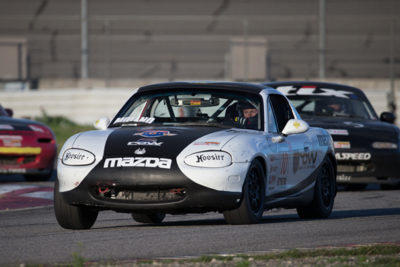The easiest way to change up the look of your race car is with a vinyl wrap, and the possibilities are endless
There’s no denying that a nicely painted car looks fantastic. There’s also no denying that painting a car is an expensive and time-consuming process, so it’s not something you want to do often. But if you want to change the color of your car every season, there’s a good way to do that: wraps.
Vinyl wraps have many advantages over paint, and Wes Molino, a Southern California Spec Miata and STL racer, knows them well. He owns ROW Signs and Graphics in San Dimas, Calif., which specializes in vehicle wraps.
“Wraps can be anything you want them to be,” explains Molino. “A wrap is a general term; it starts out as a basic decal, and you can do anything from a partial wrap all the way up to a full vehicle wrap. You can even put colors on top of colors. The big advantage to a wrap is your car never needs to go to a paint shop. You could, in theory, send a fender to the wrap shop and re-wrap it.”
So if you wrinkle a fender in a race, you can send the new one to the wrap shop before it goes on the car – although if your graphic scheme is a complicated one, you may wish to have the wrap re-applied once the fender is on the car to make sure everything lines up correctly. But from there, the possibilities are almost endless.
“You can have virtually anything printed on a wrap. You can put any color you want into it. You can do flat colors, you can do metallics, you can do chrome. One of the coolest things is you can do part of your car in a matte finish, and a different part in a gloss finish, and it really doesn’t change other than the material you’re using,” he says.
There are other advantages beyond being able to do just about anything you want graphically (and within the sanctioning body rules and Mazda Motorsports contingency rules). Jose Ramirez works at ROW Signs and Graphics and has been doing race graphics for 15 years, and has seen some of the key benefits of wraps.
“It’s much lighter,” he says, comparing it to traditional automotive paint. “When you wrap a vehicle, you don’t have to paint the whole side [instead of just one fender or door] to match the paint. It comes out exactly like it did the first time. It eliminates steps, it’s much more durable, and you can fix scratches with a torch.”
Costs can vary widely, of course. Some exotic car wraps can run $10,000, but that’s for a Ferrari that has to be perfect up close. A Spec Miata doesn’t have to be as impeccable – flaws aren’t as apparent at 50 feet away when the car is at racing speeds. “For a couple hundred bucks we can come in and do your basic sponsorship and numbers,” say Molino. “A basic vehicle wrap is a couple thousand.”
The best thing about wraps, aside from not having to painstakingly line up a bunch of different decals, is that they are easily changed. Lose one sponsor and gain another? Change the design, pull the old one off and put the new one on. As Molino notes: The design work is the best part, because you can sit down with a graphic artist and you can do virtually anything under the sun.”


 ACCESSIBILITY
ACCESSIBILITY